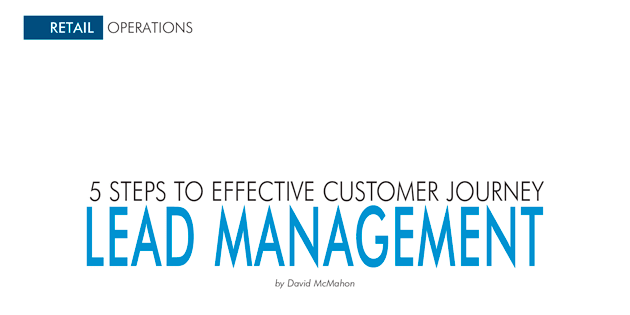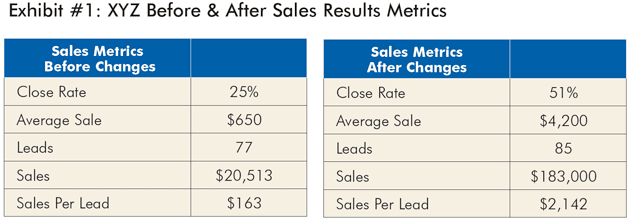
Since every
lead counts, guide non- physical leads into a funnel of care that will
deliver the highest level of service
you are capable
of providing.
Understanding the customer journey and improving customer lead management have been hot topics in recent performance group meetings I’ve facilitated. It’s a strong signal that furniture retailers have come to realize that they need to become more professional in their approach to customer lead management.
Since March of 2020, this Furniture World series has focused on managing the complete customer journey, which starts before shoppers enter physical front doors. Prior to that, one of the most important metrics retailers used was sales per guest (SPG). SPG is also known as performance indicator number (PIN) or revenue per up (RPU). Although SPG is an excellent measure of store and salesperson performance, it does not tell the whole story. That’s because SPG measures sales against physical in-store customer traffic. Today the customer journey rarely starts with an in-store visit, so SPG is good for in-store coaching, but not suitable as a way to understand true sales per actual customer lead.
Lead Management A Case Study
Today the customer journey rarely starts with an in-store visit, so SPG does not tell the whole story.
|
Retailer “XYZ Furniture” had a problem. Its two-person internet marketing team was overloaded with customer inquiries coming in via text, chat and email. Aside from updating their website and coordinating activities with various media partners, the internet team was also tasked with fielding digital leads. The following loose process had been put in place by retailer XYZ Furniture to handle these “internet sales” leads.
-
Inquiry comes in via text, chat, social media, web form or email.
-
The marketing team replies to the question.
-
The team takes the sale where the customer asks to buy or suggests that the customer come to the store.
-
No follow up.
Sample results of this process for one measured period before any changes to the process above were made can be found in Exhibit #1.

Another challenge for this retailer was managing incoming phone calls. Customer service and salespeople focused on the customers in front of them. Incoming calls were seen as disruptive and sales leads produced via phone were handled erratically. It was, therefore, impossible to measure the effectiveness of how phone calls were handled at XYZ Furniture.
Four steps were taken to improve the way incoming leads were handled for this retailer. Please note that every organization operates under a different set of circumstances, so any process change must be adapted to the specific situation at hand.
Step #1: Appoint a Leader
In any retail organization, answering the phone, taking chats, responding to emails and other incoming customer purchase inquiries is vitally important. Appointing a leader to manage the process of handling leads is justified. This role should generally fall under the umbrella of the sales department rather than marketing. That's because getting high quality leads is the responsibility of marketing and successfully acting on those leads is a sales function. Retailers that fail to assign responsibility find that some employees perform their tasks well, some poorly, and the rest somewhere in between. Greatness does not come from producing average results.
XYZ Furniture, therefore appointed a digital lead manager reporting to the retailer’s director of sales.
Step #2: Lead Management
All top sales teams who handle walk-in store traffic need to have access to refined selling systems. Teams responsible for responding to virtual lead traffic should have excellent systems and processes in place, as well. Systems define outcomes. Four outcomes XYZ Furniture specified for its new digital lead manager to achieve more often were:
The path for lead management— be it audio, video or keystroke communication—is similar to an in-store visit. For example, when a customer walks into your store you say, “Welcome!” and introduce yourself, right? You probably ask the prospect for her name, where she lives and what room she plans to improve. That’s how the non-physical lead process should start too. A conversation must be started to gain an understanding of a shopper's situation in order to suggest the best solutions. Only then can permission to close be obtained. The close may be a transaction, an appointment with an expert, or a follow up of some sort.
Step #3: The Team
Create a lead management team. It may consist of just one person at the start, but is likely to grow over time as its successes and worth are realized. Make sure that your team is not working in isolation. Lead management can and should be an important link between marketing and the sales force. Done right, this department will be seen as helping to make your marketing more effective. And, your sales force will see lead managers as a direct feed of quality, warmed-up, prepared customers.
Done poorly, especially when positioned underneath marketing and transacting business as a separate department, "Internet Sales" can be seen by a physical, brick and mortar sales force as competition. This type of atmosphere hurts customers and the entire sales organization. That’s why it is important to seek optimal information flow and coordination between marketing, lead management and sales.
Step #4: Log the Journey
Log the customer’s journey from the first point of contact to communicate better throughout the buying cycle and beyond.
When introduced to the concept of having employees log customer data, many furniture retailers respond by saying that their employees won’t do it. And, they are right! It cannot happen if management doesn’t BELIEVE it can happen.
If your competition successfully implements a lead management system that includes logging the customer journey and you don’t, they will gain an edge through better customer interaction. Will you let this happen? Or, will you attract customers with more advertising and discounting instead?
I think you get my point here: It is probably better to put the leads that your marketing dollars generate into a funnel with one hole rather than investing in a bucket with 50 holes. It’s a much better way to execute more sales and do better than competitors in your marketplace.
So, how will your employees log and track leads? There are many ways to do this including using a whiteboard, Excel or ERP/POS system. Leads can also be tracked in a separate CRM system or kept in the systems where they originated, for example, Facebook, Podium, Perq, or email. Telephone leads need to be recorded somewhere if you want to get a handle on how well your people are converting calls to sales. Wherever your non-physical leads are tracked, if you decide to organize and measure them to achieve continuous improvement, you will need to consolidate them. A future article will discuss this in more detail.
It is probably better to put the leads that your
marketing dollars
generate into a funnel with one hole rather than investing
in a bucket with
50 holes.
|
Step #5: Measure
Develop measurements, measure routinely, set benchmarks.
If a business process is worth improving, start by tracking it. Non-physical leads come from a variety of channels, such as: social media, webchat, text, telephone calls, email and proactive employee follow up using one of the above.
Record where customer leads came from and record the technology used. For example, a webchat initiated via Podium, an email via Perq or an incoming phone call signals the start of a customer’s journey. From there, the continued conversation can be documented. The ongoing conversations, appointments and customer follow-up will be considered pending until a sale is made or the customer in no longer reachable. Through the process of tracking customer journeys, a variety of metrics can be looked at, including sales per lead.
Depending on the data that is available to you and how easy it is to query, you should measure your total sales volume divided by total customer leads. Or, you may separate sales into two parts: Sales volume generated from non-physical lead referral (SPL) and sales volume from unknown sources (SPG). Either way, this will put you on the road to setting standards for improvement. The result will be happier customers and employees.
Other measurements that may also prove useful include:
-
Sales dollars by lead source.
-
Percent of leads by source is equal to Lead source/Total Leads. This measure is used to determine how leads rank in terms of customer usage.
-
Sales dollars by unique web user: This is your total sales divided by unique users on your website.
-
Average sale and close rate for appointment leads.
Following changes to XYZ Furniture’s lead management processes, close rate doubled and average sales produced by making appointments for customers who needed help went up by over 500 percent. Sales attributed to handling non-physical leads more effectively was evident in the increase of the sales per leads (SPL) metric to $2,142—a 1,200 percent increase. These metrics can be found in the table at the bottom of page 10.
Customer Journey Management is
necessary for the
long-term survival
and prosperity of retailers who want to compete
in an omni-channel world.
|
Next Steps
It is pretty clear to me and most of my clients that better handling, tracking and measuring of leads created from understanding the real customer journey is a sizable opportunity. In fact, Quality Customer Journey Management is necessary for the long-term survival and prosperity of retailers who want to compete in an omni-channel world that blends the non-physical and physical together.
Every lead counts. Non-physical leads must be managed professionally. Put them into a funnel of care that will deliver the highest level of service that you, the multi-channel retailer, are capable of providing. Look at your current processes. Ask yourself, “What can I modify to make these processes better for everyone?” Then, develop and implement new processes, measure results, and proceed along your continuous improvement journey.